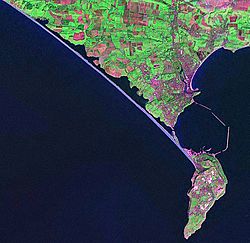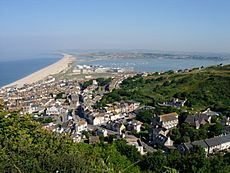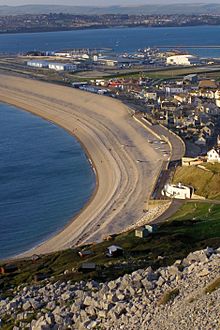Chesil Beach facts for kids

Chesil Beach, sometimes called Chesil Bank, in Dorset, southern England is one of three major shingle structures in Britain. Its name is derived from the Old English ceosel or cisel, meaning "gravel" or "shingle".
It is a kind of offshore barrier which has joined the mainland with Portland Bill. The lagoon between the chesil and the mainland is called The Fleet or The Fleet Lagoon.
The shingle beach is 18 miles long (29km), 220 yards wide (200m) and 50 feet high (15m). The beach and the Fleet are part of the Jurassic Coast, a UNESCO World Heritage Site, and the location for a book, On Chesil Beach by Ian McEwan.
At the eastern end of the beach at the village of Chiswell, against the cliffs of the Isle of Portland, the beach curves round sharply to form Chesil Cove. This part of the beach protects the low-lying village from flooding. Westwards the shingle forms a straight line along the coast, enclosing the Fleet, a shallow tidal lagoon. The lagoon is 9½ feet (3m) at its deepest.
The beach provides shelter from the prevailing winds (from the west) and waves for the town of Weymouth and the village of Chiswell, which would otherwise probably not exist
Varying with the Bank's unbroken increase in height, to 14.7 metres (48 ft), above mean high water, the size of the flint and chert shingle varies from pea-sized at the north-west end (by West Bay) to orange-sized at the south-east end (by Portland). It is said that smugglers who landed on the beach in the middle of the night could judge "exactly where they were" by the size of the shingle.
Images for kids
-
Highball bouncing bomb prototype, now on display at Abbotsbury Swannery
-
Looking west down Chesil Beach by Abbotsbury
See also
 In Spanish: Chesil Beach para niños
In Spanish: Chesil Beach para niños











